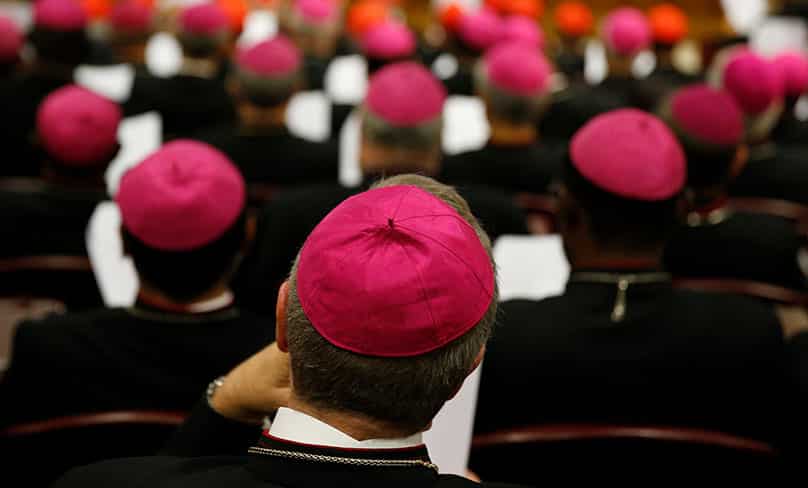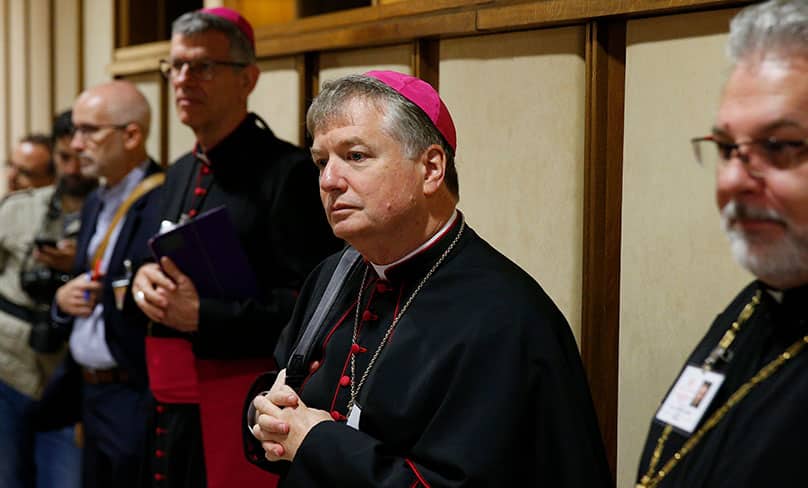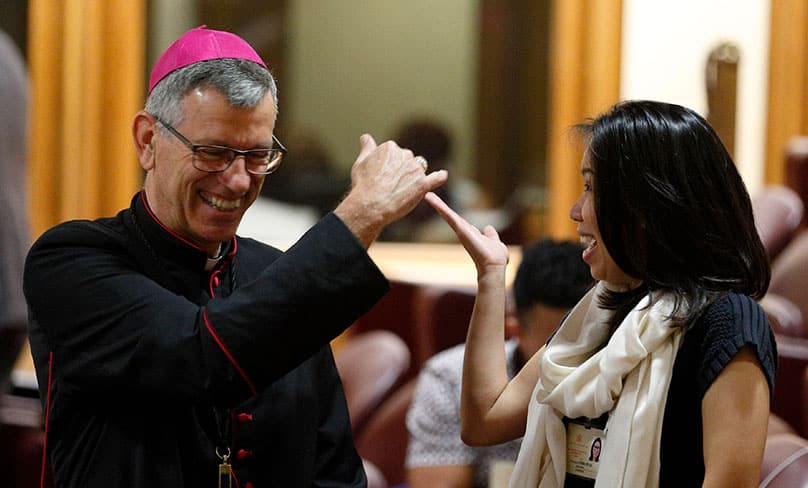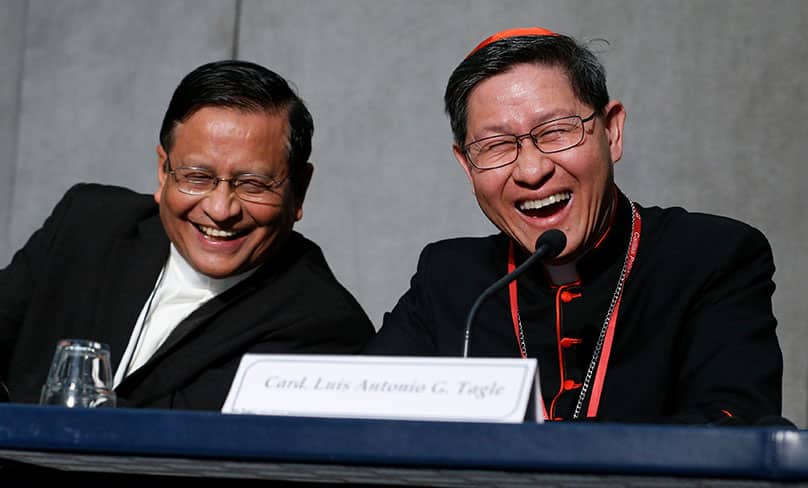
COMMENTARY
THE DRAFT FINAL REPORT: SOME FIRST OBSERVATIONS
No one should envy the actual wordsmiths who had to do the heavy lifting, behind the scenes of the drafting commission, to produce a draft final report for Synod-2018, which was given to the Synod fathers yesterday morning. Not only did those drafters have to contend with the hundreds of proposals offered to the Synod in its general assemblies as well as in its discussion groups; an even greater challenge involved navigating the fault lines in the Catholic Church that Synod-2018 has made unmistakably clear. It’s worth noting some of those fault lines before offering some first observations on the draft final report itself.
The first is the fault line between those who are determined to make the “See-Judge-Act” method pioneered by the Young Christian Workers movement almost ninety years ago the normative structure for Church documents – which puts a premium on sociological analysis as the entry-point for ecclesial reflection – and those who think that beginning with divine revelation, especially in the Bible, is the appropriate place to begin a Catholic reflection on anything and everything.
There is the fault line between those determined to make Pope Francis’s apostolic exhortation Amoris Laetitia the single, controlling interpretive framework for all of Catholic moral life (which inevitably minimizes the normative character of John Paul II’s 1993 encyclical Veritatis Splendor), and those who believe the ambiguities in Amoris Laetitia must not become the occasion to deconstruct the classic norms of Catholic moral teaching and pastoral practice.
Then there are the many fault lines caused by the vastly different pastoral experiences of the local Churches, some of which face active persecution or war and some of which confront the challenge of affluent decadence; how does a synodal document speak to all those experiences?
And there is the fault line between those whose concept of a “listening Church” seems to preclude much of the Church’s classic teaching function, and those who believe that what young adults today are looking for is a Church that knows where it wishes to lead humanity and teaches clearly, always with compassion, but also with conviction.
Given these fault lines, the draft final report is better than some expected, or even feared. There is an effective, even touching, use of the Emmaus story in Luke 24 as the biblical “frame” for the document. There is a strong section condemning sexual abuse by anyone; a frank acknowledgment of the irresponsibility of bishops in failing to discipline abusive priests; and a recognition of how great an obstacle clerical sexual abuse is to evangelization. The draft final report links baptism to mission in a way that reflects Pope Francis’s challenge, often forgotten amidst recent battles, that Catholicism should become a Church of radically converted disciples, permanently in mission.

But there remain some problems that should be addressed in the days ahead, before the Really Final Draft Final Report is voted on, paragraph by paragraph, thereby producing the Final Final Report.
The paragraphs on sexual abuse would be strengthened and made more credible to lay people if the abuse crisis were not blamed on “clericalism.” No one doubts that clericalism is a problem in the Church, not least in Latin America. But to turn it into an all-purpose explanation of clerical sexual abuse is to ignore the sexual dysfunction that is manifestly the primary cause of sexual abuse by anyone. There is unambiguous and overwhelming empirical evidence of the linkage between certain forms of sexual dysfunction and clerical sexual abuse, and that should be acknowledged.
The report’s discussion on family would be much improved by a reflection on the vocation of fatherhood, which is typically ignored or minimized in western culture, with serious social effects. Motherhood is praised in the document, but Dad gets short shrift; that has to change.
At several points the draft final report falls into Newspeak about “constructing” one’s identity, usages that seem to veer perilously close to the post-modern notion that every facet of one’s identity, including “sexual identity,” is a matter of assertion rather than reality. That is not what we know from revelation, and any ambiguities on this point require correction.
Throughout the Synod, the German-language discussion group insisted that the Church’s teaching on sexuality and the ethics of human love ought to be more “elaborated,” anthropologically and theologically; the implication seemed to be that this had not been done over the centuries, most recently in the Theology of the Body. The language of “elaboration” appears at several points in the draft final report, and that language should be modified or even eliminated. Those changes might also be the occasion for a positive affirmation of chastity as the integrity of love, which is everyone’s vocation. No one doubts that the Church ought to teach its ethic of human love more persuasively and winsomely, But to suggest, as the Germans did and the draft final report does, that Catholicism hasn’t had much of interest or consequence (or pastoral effect) to say about all this before now is just nonsense – and a form of pandering to dominant western cultural shibboleths.
“Discernment” is discussed at considerable length in the document, but almost always in affective terms. To reduce “discernment” to a matter of subjective sentiment and feeling leaves little room for a synodal affirmation of the life of the mind, for a synodal demand for catechetical excellence as an integral part of Christian formation, or for a synodal acknowledgment that theology can be a means of discernment. In both the Synod’s general assembly and in its discussion groups, there were numerous critiques of what bishops described as the anti-intellectualism of the Synod’s working document, but those concerns have not been adequately addressed in the draft final report. They should be; the notion that the pontificates of John Paul II and Benedict XVI were “too intellectual” should not inform an ecclesial document today, not least at a cultural moment in the West of massive intellectual confusion.
The draft final report makes a clear and welcome statement that the Church does not categorize or identify people by their sexual appetites or desires. But it needs greater clarity on the normativity of marriage rightly understood, and while affirming the Church’s love for all, the document should more forcefully call all of us to chaste love, in either its married or celibate form.
There remains, in short, work to be done to bring this Synod to a successful conclusion, and to close loopholes of ambiguity that might be exploited in the post-synodal process. That promises an interesting four days here in Rome.
– Xavier Rynne II

TESTIMONIES FOR THE SYNOD
[Yesterday, LETTERS FROM THE SYNOD-2018 #15 was pleased to offer our readers the first portion of “Becoming Fire,” Cardinal Thomas Collins’s September 2018 keynote address to the U.S. National Conference of Diocesan Vocation Directors at its annual meeting, held this year in Scottsdale, Arizona. In the first two parts of his address, Cardinal Collins urged that vocations directors and seminary formators be themselves formed by the “Fire of Sacrificial Love” and the “Fire of Purification.” The cardinal’s reflections conclude today, prefaced by a reprise of the opening of his NCDVD address. XR II]
BECOMING FIRE
Part Two
Thomas Cardinal Collins
I have long been intrigued by a story from the days of the Fathers of the desert. A young monk – one might almost say, a seminarian – who is discouraged, approaches one of the venerable elders, and laments that despite all his efforts at holiness – fasting, hours of prayer, following the rules of the community, and so on – he has made no progress, but is overcome with a sense of desolation and fruitlessness. Not only is he not advancing in holiness, but he is slipping further into sin. The old monk looked at him, stretched out his hands, and flames shot out of his fingers. He said: “You must become fire.”
I believe that this story is instructive for all of us as we seek to be better disciples of Jesus, daily growing in holiness, and particularly for those who are called by Jesus to fulfil the mission of his apostles, and to help invite others whom he is calling to discern their vocation, and to enter formation for the holy priesthood. We must become fire.
If we who are bishops and priests do not become fire, and if those preparing for the priesthood do not, but instead become trapped in the dark and cold embrace of the world, the flesh, and the devil, then we are bound for destruction, for the lake of fire that is described in the Apocalypse (Revelation 20: 13-15), and we fail those entrusted to our pastoral care. As we are all aware, that has happened since the days of Judas, and is much in the news now. If the flame entrusted to us at Baptism, Confirmation, and Ordination flickers and dies, or is abruptly extinguished, and the darkness of evil envelops the priest or bishop, then havoc is wrought upon the most vulnerable, and the splendor of the Holy Priesthood is sullied, and hidden from those whom God is calling to be priests of Jesus Christ. Satan entered into Judas, the light went out, and it was night (John 13:27-30).
So we must become fire.
I propose to reflect upon four facets of the scriptural theme of fire, and to apply them to the priestly life and to the ministry of encouraging and guiding those who are called to the Holy Priesthood. I will also make a few observations about how some priests and bishops have gone over to the dark side, but that must not be the focal point of our thoughts or actions. It is better to light one candle than to curse the darkness. Evildoers must be held accountable, and we do indeed need to know how not to end up in the Lake of Fire, and devote appropriate attention to that, but as Bishop Sheen used to say: it is better to fill the box with salt than to concentrate on the pepper. We focus on virtue, not vice; on light, and not darkness. We would be naïve not to take note of the wickedness of Babylon, whose discord and darkness is destroying this earthly city through which we are passing, and has clearly infiltrated deep into the Church itself, but our hearts must be set on the fiery, dazzling beauty of our true home, the heavenly Jerusalem.
And so we must become fire. How do we do that?
I will propose these four facets of the theme of fire that can focus our thoughts, move our will, and guide us in our actions:
The Fire of Sacrificial Love: This is a common theme in scripture. The sacrificial offering is totally consumed by fire, as we must be by our priestly mission. We are not to hold back, but to give our lives fully to Christ and his people, a fact that is also symbolized in the ordination rite when we lie prostrate before the Lord during the Litany.
The Fire of Purification: This is a frequent theme in both Old and New Testaments. Fire destroys that which is evil, which must be burned away. And gold and silver are tested in fire. (Sirach 2:5; I Peter 1:7) If we are to serve the Lord, and to invite others to do so, we must experience constant purification, and live in a spirit of repentance. Let the weeds and chaff within our hearts be thrown into the fire. We are currently going through a great and life-giving purification in the Church. The scandal is not that we become aware of evil in the Church, and to our shame so does the world around us; the true scandal is that evil occurs in the Church, and it is at its worst when it is hidden. The truth will set us free.
The Fire of Pentecostal Zeal. God came down in tongues of fire upon the apostles, cowering in fear, and they were granted apostolic zeal, that boldness which we see in the Acts of the Apostles. The early servants of God were on fire with the Gospel. So must all disciples of Jesus, and especially all who are called to the Holy Priesthood.
The Fire of Majesty and Mystery. Every priestly vocation begins at the burning bush (Exodus 3:1-12), in the presence of the majesty and the mystery of God. A vocation is not a career, but a personal call to the service of the Lord God and of his people. It is sublime, and it is divine. Profound awareness of the majesty of the Lord who calls us must penetrate to the depths of our souls; if it does not, then priesthood and episcopate can become worldly, and can be corrupted….

The Fire of Pentecostal Zeal
In my former life of almost twenty years of preparing seminarians for the priesthood, I recall discussions of men who were not obviously incompetent or immoral, who might even be doing quite well academically, but who seemed to be inert. They were drifting towards ordination, with no clear reason to stop them. But did they have the apostolic fire? Were they driven by a true love for Jesus? Or were they simply going through the motions?
Someone who is ordained needs to have the apostolic fire of Pentecost: “When the day of Pentecost had come they were all together in one place. And suddenly a sound came from heaven like the rush of a mighty wind, and it filled all the house where they were sitting. And there appeared to them tongues as of fire, distributed and resting on each one of them. And they were all filled with the Holy Spirit and began to speak in other tongues as the Spirit gave them utterance.” (Acts 2:1-4)
Some are introverts, and some are extraverts. Some have more lively personalities, and some are more quiet. Those superficial temperamental characteristics are irrelevant. Exuberant zeal is not required and may in fact become a problem. But deep within, each person who is to be ordained must burn with the Pentecostal fire. As the prayer at one of the ritual Masses for ordination says: “make these your servants worthy ministers of your altar, and ardent yet gentle heralds of your Gospel.” Priests and bishops, and seminarians, must be ardent: they must be on fire with zeal to serve God and his people. The fire of Pentecost must burn away all self-referential careerism, as we boldly head out into the streets of the secular city, like the apostles after Pentecost, in love with the Lord and forgetful of self, ready to lose ourselves in our priestly ministry.
So we search for candidates who already burn with the Pentecostal fire, and who show it by their acts of generous initiative in their parish and in the activities of their life in society. Our seminary formation program must provide opportunities to develop and manifest that zeal. I don’t want to ordain a dead battery. One of the joys of working with candidates for the priesthood, as I have done almost all of my priestly life, is to have the privilege of being with zealous and inspiring seminarians. And that is one of the greatest joys of being a bishop, as I have been now for twenty one years: to be the bishop of such zealous and inspiring priests.
If a priest is himself alive and on fire, then he will be able to pass that on to others, as the flame of the Paschal candle spreads from taper to taper throughout the church at the Easter vigil, until the whole church is bright with the light of Christ. It has been said that education is not filling a bucket, but lighting a fire; that is even more true of evangelization. We must keep in mind the example of the Lord Jesus on the road to Emmaus. The two disciples marvelled: “Did not our hearts burn within us while he talked with us on the road, while he opened to us the scriptures?” (Luke 24:33)
So that is what we should look for in candidates for the priesthood: men who are on fire with love for our Lord and with zeal in his service. And we need in our program of formation to help the seminarians become so profoundly committed to the life of holiness, that the fire will burn steadily and quietly throughout their priestly life. There are two times when a priest or bishop is horizontal in Church: face down at his ordination and face up at his funeral. In every moment between those two points, he must be on fire with sacrificial love and priestly zeal.
The Fire of Majesty and Mystery
We must become fire, and we catch that fire from the burning bush, where Moses discovered his vocation. It is in contact with the mysterious majesty of God that we discover and daily renew our vocation to the holy priesthood. Priests are not branch managers, and bishops are not CEO’s: woe to those who think in those terms, or who think of a priestly or episcopal career. We are unworthy servants and messengers of the living God, and we must live our mission in this fallen world always conscious of the glory of the heavenly Jerusalem, which is our home.
If we look to the vocation stories of the Old Testament, so often they are set in the context of divine glory, of the fire of majesty and mystery. God makes a covenant with Abraham in a fiery theophany of sacrifice (Genesis 15:12-21), and Moses hears the Lord’s voice from the burning bush. Isaiah receives his vocation in the temple, in a vision of the glory of the Lord, as an angel of God touches his lips with a burning coal. Elijah passes his mantle to Elisha, and is swept up into heaven in a chariot of fire. (II Kings 2:9-11) Jesus reveals his glory in the transfiguration on Mount Tabor, and Paul is dazzled by divine light in the road to Damascus.
A vocation to the Holy Priesthood is never prosaic; it is always glorious, though it is rare that the glory is as visibly manifested as in the Biblical vocation accounts. We are servants of the living God, and must never forget it. Some have forgotten it, as did Judas when Satan entered into him, and it was night. But that requires effort to resist God’s grace. There is a marvellous image of the Last Supper in the chapel of Prince of Peace monastery near San Diego: there are shiny haloes over Jesus and all of the apostles at the table. But on the left, Judas is leaving the table, and walking away from his halo. Bishops and priests have sometimes done that.
We need to be conscious of the sacred office that was entrusted to us at ordination. We are stewards of the mysteries of God. To use that sacred office for personal benefit is simply wrong. I used to advise my seminarians that when they are priests they should go to the end of the line, unless doing so would be false humility that insults others, and wear clerical attire, as a sign of their mission, though not when buying a car.
So our vocation ministry must be founded on a profound awe of the privilege of being called to serve the Lord God as priests. And the holy priesthood must be treated with reverence – the priesthood, not the priest. Clericalism is not too high an estimation of the priesthood, but too low an estimation: it is using the holy priesthood to advance one’s personal desires, as sadly has happened. The priesthood is to be lived with sacrificial love, not used. If bishops or priests use their sacred office to dominate others, to take advantage of people’s quite appropriate reverence for the priestly office, or to manipulate that reverence to satisfy the cleric’s self-indulgent desires, then that is not simply evil; it is sacrilegious evil.
Every day we need to remind ourselves of the majesty of the Lord, whose servants we are. That is one reason why making a daily holy hour of adoration is such a good idea, and why the celebration of the Eucharist, and Eucharistic adoration, should be at the heart of our vocation efforts. In any case, all Jesus ever told us about vocations was to pray to the Lord of the harvest to send labourers into harvest. We need constantly and consciously to return to Mount Tabor, and to the heavenly Jerusalem, if we are to be faithful and fruitful in our priestly ministry in this vale of tears. As we pray before the tabernacle, the fire of the sanctuary lamp is a visible sign of the majesty and mystery of God.
You must become Fire
In every age until the end of time the Holy Priesthood is entrusted to frail and sinful men. Many priests have become famous as saints; most priests try earnestly each day, by God’s grace, to be faithful and humble servants; and some priests have betrayed their mission and their Lord. The priesthood of Jesus Christ is glorious, but we are not. We are called not just to do the minimum, or to shine by our own light, or to advance within the earthly structure of the church; we are called to become fire.
We must burn with the fire of sacrificial love, not holding back, but offering everything we have and are to Jesus and to the mission upon which he sends us. We must be repentant, alert to God’s justice, and trusting in his mercy, made holy in the fire of purification.
We must be filled with the fire of Pentecost, boldly proclaiming Christ in the darkness of the secular world.
And with awe and wonder we daily come before the Lord in prayer, meditating on his Word and receiving new life from him in the celebration of the Eucharist and in Eucharistic adoration, seeing reality as it truly is, in the light of the fire of divine majesty and mystery.
The young man said: what must I do? And the wise elder replied: you must become fire.
